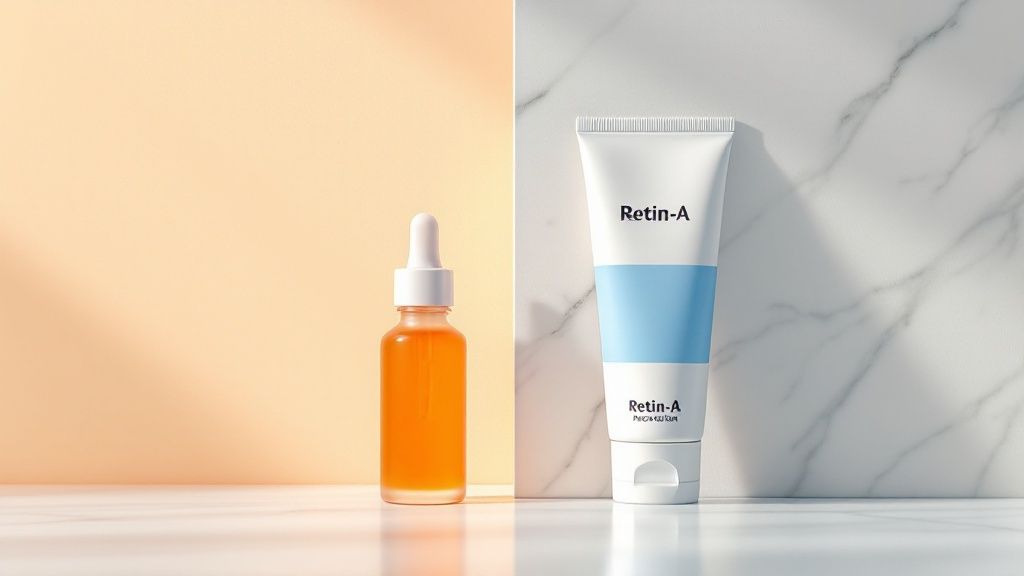
When you hear people talking about the retinol vs Retin A debate, what they’re really discussing is a question of power versus patience. It all boils down to one simple difference: Retin-A is pure, prescription-strength retinoic acid that gets to work the second it hits your skin. Retinol, on the other hand, is its gentler, over-the-counter cousin that your skin has to convert into retinoic acid first, making it a much slower, more gradual journey.
Decoding the Core Differences
At a glance, retinol and Retin-A look like two sides of the same coin. Both are derivatives of vitamin A, and both are famous for their incredible anti-aging and acne-clearing abilities. But how they’re built chemically and the way they behave on your skin creates a massive gap in their performance, the results you’ll see, and who should actually be using them.
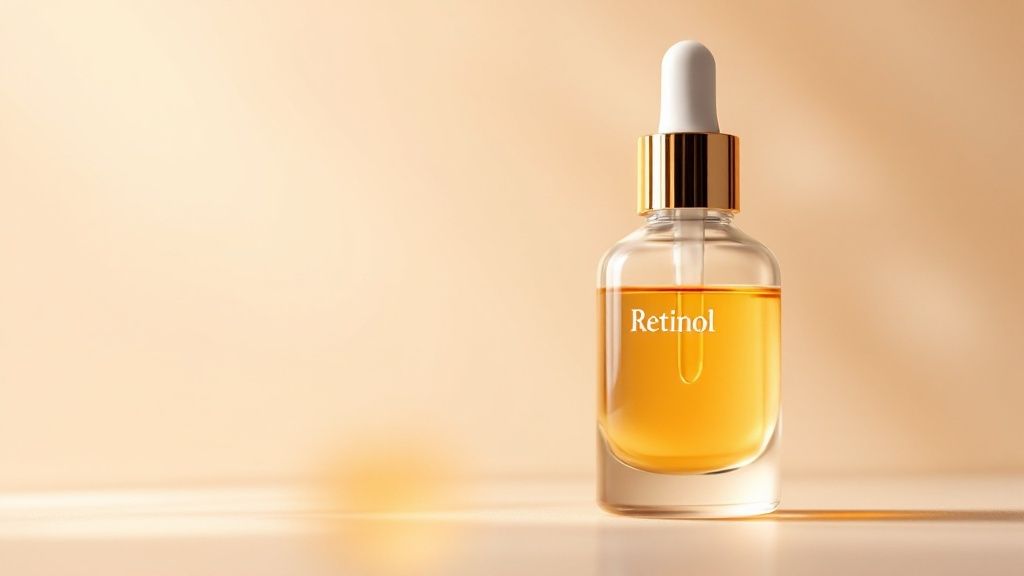
Getting this distinction right is everything. It’s the key to picking the ingredient that will actually help you reach your skincare goals instead of leaving you with a red, peeling mess. One is a fantastic preventative staple you can grab in any cosmetic aisle, while the other is a heavy-hitting treatment prescribed by dermatologists for serious, clinical-level concerns.
Retinol vs Retin A At a Glance
To make things simple, let's put them head-to-head. This table gives you a clear, side-by-side look at what truly sets them apart, helping you instantly see which one aligns with your skin’s needs and tolerance. A good way to think about it is this: retinol is your trusty daily driver, while Retin-A is a high-performance sports car. Both will get you where you want to go, but the speed and intensity are worlds apart.
| Attribute | Retinol | Retin-A (Tretinoin) |
|---|---|---|
| Availability | Over-the-counter (OTC) | Prescription-only |
| Potency | Lower; much gentler on the skin | High; ~20 times stronger than retinol |
| Mechanism | Needs a two-step conversion process in the skin to become active retinoic acid. | Is pure retinoic acid; works immediately on application without needing conversion. |
| Best For | Beginners, sensitive skin, preventative anti-aging, and mild texture issues. | Moderate to severe acne, significant sun damage, and deep-set wrinkles. |
| Side Effects | Milder chance of dryness, redness, and peeling, especially when you first start. | Higher likelihood of major irritation, peeling, and dryness (the dreaded "retinization" phase). |
| Time to Results | Slow and steady; you'll see improvements in 8-12 weeks or more. | Much faster; acne can start clearing in as little as 6-8 weeks. |
Ultimately, the right choice depends entirely on your skin's history and your ultimate goals. While Retin-A delivers faster, more dramatic results, it comes with a much higher risk of irritation. Retinol offers a gentler path, perfect for those just starting out or with sensitive skin.
How Retinoids Actually Transform Your Skin
To really get into the “retinol vs Retin-A” debate, we have to look under the hood at what’s happening on a cellular level. Both are derivatives of vitamin A, famous for their ability to “talk” to your skin cells and kickstart some pretty incredible changes. Their main job? To speed up skin cell turnover—the process of shedding old, dull cells to make room for fresh, healthy ones.
This rapid-fire renewal is the secret sauce behind their power to unclog pores, smooth out texture, and fade discoloration. But they don't stop there. Retinoids also dive deep into the skin's dermal layer to fire up collagen production. This is huge, because collagen is the protein that gives skin its firm, bouncy feel, and it naturally dwindles as we age. By giving it a boost, retinoids help plump the skin from within, softening fine lines and wrinkles over time.
The Conversion Pathway is Everything
The fundamental difference between retinol and Retin-A comes down to how they get the job done. Retin-A is pure tretinoin, also known as retinoic acid. This is the bioactive form your skin cells can immediately recognize and put to work. Think of it like a key that fits the lock perfectly—no fumbling required. It binds directly to the retinoic acid receptors on your skin cells, telling them to start renewing themselves right away.
Retinol, on the other hand, makes your skin do a little extra work. It has to go through a two-step conversion process inside your skin to become the active retinoic acid that actually creates change.
This image breaks down the biochemical journey retinol takes to become active.
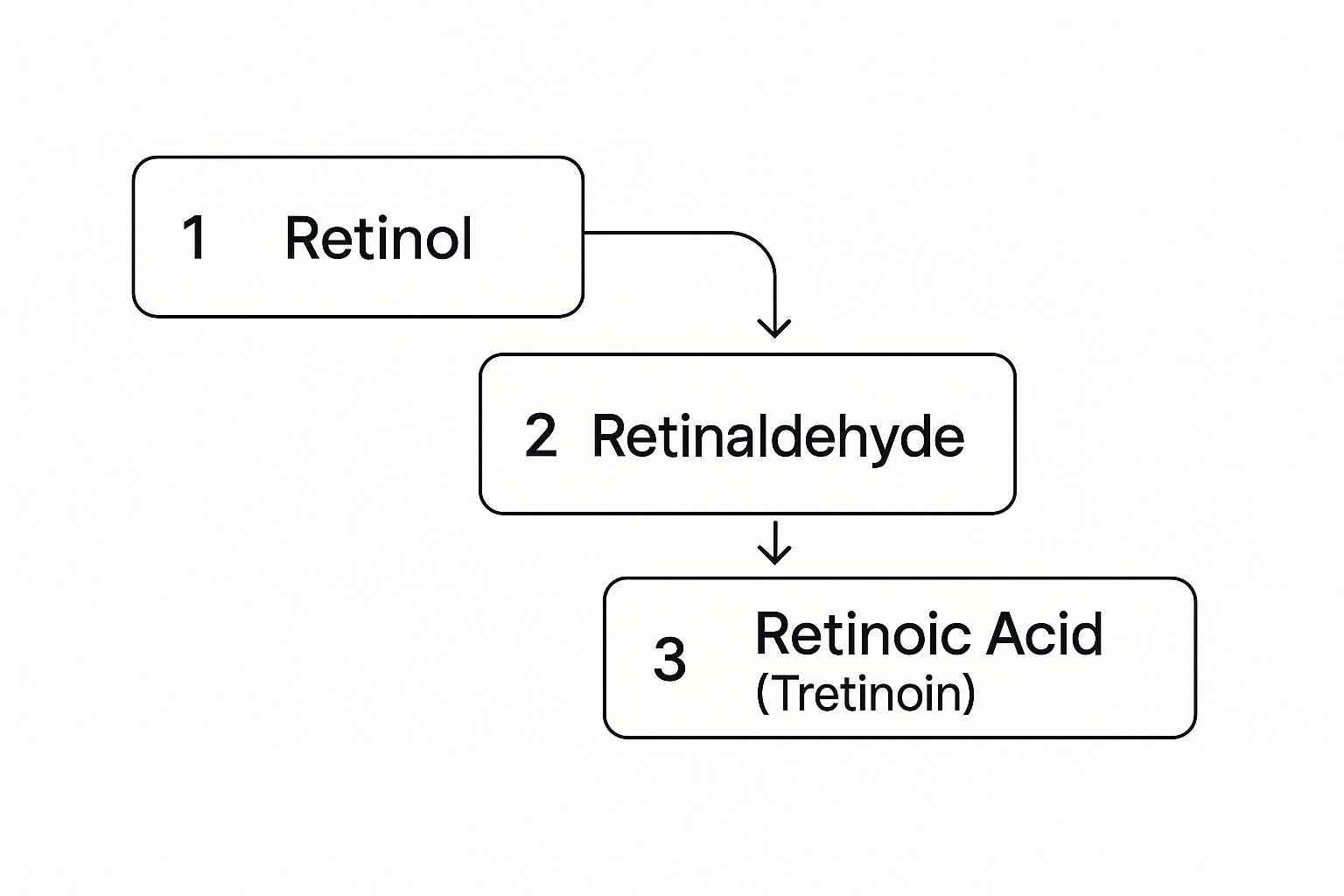
As you can see, this multi-step process means not all of the retinol you apply actually becomes active. That’s why it’s inherently gentler but also works more gradually than its prescription-strength cousin.
Potency and Patient Perks
This conversion process is the core reason for the differences in strength and potential irritation between the two.
Because Retin-A is already in its active state, it delivers a more potent, immediate message to the skin cells. This efficiency is why it produces faster, more dramatic results for concerns like severe acne and deep-set wrinkles, but also why it carries a higher risk of causing redness, dryness, and peeling.
For those looking to complement a powerful retinoid routine, consider tools that support skin health. The BARB N.P. Facial Mask is an excellent addition. Its red light therapy setting can help calm inflammation and further support collagen synthesis, which is especially beneficial when your skin is adapting to a new active ingredient. This wireless mask is designed for comfort, fitting snugly on your face while its three lighting settings offer different treatments to enhance your skincare results. Retinol’s slower, multi-step activation provides a gentler experience, making it an ideal starting point for beginners or those with sensitive skin who are focused on preventative care and improving overall skin tone and texture.
Exploring Retinol: The Over-The-Counter Favorite
Walk down any skincare aisle, and you'll find retinol lining the shelves. It's the celebrated hero ingredient you can buy without a prescription, and for good reason. As the most accessible member of the retinoid family, retinol is the perfect starting point for anyone looking to dip their toes into the world of vitamin A. It's the go-to for beginners or those with sensitive skin.
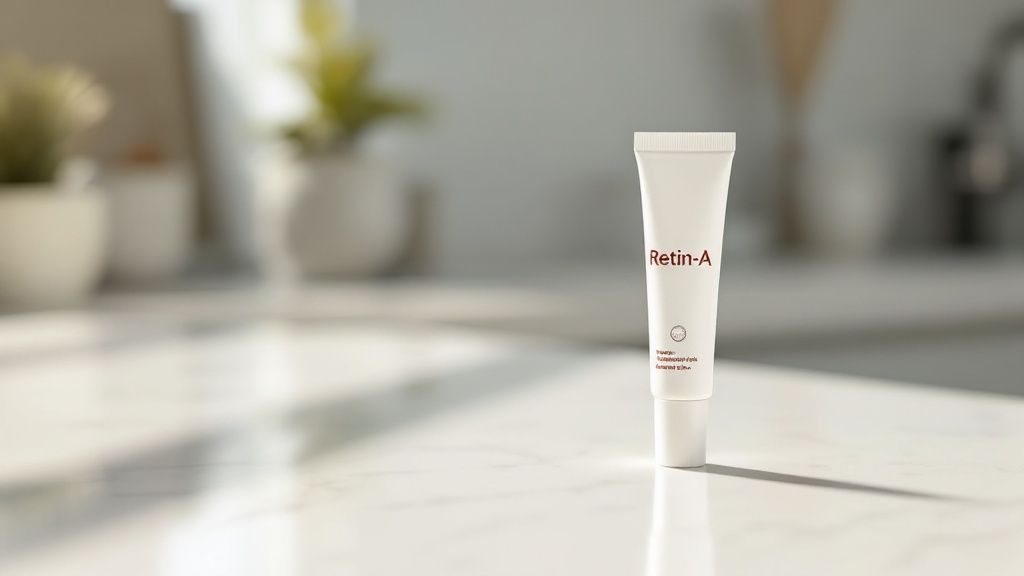
Unlike its stronger, prescription-only cousin in the retinol vs retin a debate, retinol works its magic more gradually. It’s known for delivering proven benefits—smoothing fine lines, refining rough texture, and evening out skin tone—but it does so over time. This gentler pace makes it ideal for preventative anti-aging, helping you maintain a radiant complexion with minimal irritation or downtime.
Navigating OTC Concentrations
One of retinol's biggest strengths is the variety of concentrations available, which usually range from a mild 0.01% up to 1.0%. This flexibility is key, as it lets you find a product that perfectly matches what your skin can handle. The golden rule here is always start low and go slow.
- For Beginners: Stick with a low concentration, around 0.01% to 0.03%, and only apply it two or three times a week to start.
- For Intermediate Users: Once your skin has adjusted without any drama, you can slowly move up to moderate strengths like 0.04% to 0.1%.
- For Experienced Users: If your skin is resilient, you might eventually work your way up to higher concentrations of 0.3% to 1.0% for more dramatic results.
This tiered approach lets your skin build tolerance, which is the secret to minimizing the redness and peeling that can sometimes pop up. If you're worried about those initial reactions, our guide on how to handle potential retinol serum side effects can help you manage them.
A Gentle Giant in Skincare
Retinol's widespread popularity comes down to its incredible balance of effectiveness and tolerability. It's no surprise the global retinol market was valued at around USD 1.33 billion in 2022 and is expected to hit USD 1.79 billion by 2030, largely because it's become a staple in so many personal care products.
The key to seeing real change with retinol is consistency and patience. Because it has to convert into retinoic acid in the skin, it takes longer to see results—often between three to six months of regular use. But for those who are willing to play the long game, the payoff is smoother, brighter, and healthier-looking skin.
A great starting point is the BARB N.P. Retinol Serum, which is formulated to be effective for anti-aging while remaining gentle enough for those new to vitamin A.
Understanding Retin-A: The Clinical Gold Standard
If retinol is your entry point into the world of vitamin A, then Retin-A is the destination for serious, targeted results. Known by its generic name, tretinoin, this isn't just a stronger version of what you find on store shelves—it's a powerful, prescription-only medication.
Retin-A is pure retinoic acid, meaning it doesn't need your skin to convert it. It gets to work immediately. This is why dermatologists consider it the gold standard for tackling moderate to severe acne, significant sun damage, and deep-set wrinkles that over-the-counter products just can't touch.
A Medically Supervised Solution
The most critical difference in the retinol vs. Retin-A debate is that Retin-A is a regulated drug. Its sheer potency demands a doctor's guidance. A dermatologist will assess your skin and prescribe the right strength and frequency—trying to use it without that professional oversight is a fast track to severe irritation and a compromised skin barrier.
This medical supervision is non-negotiable, especially during the initial adjustment phase known as the "retinization" period. Your skin has to get used to it, and that process can be intense, often lasting several weeks.
- Intense Dryness: Your skin might feel uncomfortably tight and parched.
- Noticeable Peeling: As cell turnover kicks into high gear, expect flaking and shedding.
- Significant Redness: Inflammation and sensitivity are very common as your skin adapts.
These side effects are signs that the tretinoin is working, but they need to be carefully managed with a simple, supportive skincare routine.
The tretinoin market is enormous for a reason—it’s a medical powerhouse. Valued at an estimated USD 22.3 billion globally in 2024, its growth to a projected USD 38.09 billion by 2033 reflects just how many dermatologists rely on it to treat conditions like acne and photoaging. You can learn more about these tretinoin market trends from DataM Intelligence.
Clinical Efficacy and Results
For those who stick with it under a doctor’s care, the payoff is huge. Clinical studies have shown time and again that tretinoin delivers visible improvements that OTC products simply can't replicate. It's incredibly effective at clearing stubborn acne by keeping pores from getting clogged and has a proven ability to boost collagen production, which helps smooth out wrinkles and firm up the skin.
To help your skin through this intensive treatment, think about adding complementary therapies. An at-home LED device like the BARB N.P. Facial Mask is an excellent partner. Its red light setting is known to help calm inflammation and support collagen synthesis, which can be a huge relief during that tough retinization period. What makes this mask stand out is its comfortable, wireless design and three different light settings, so you can customize your treatment as your skin's needs change while it gets used to Retin-A.
Making the Right Choice for Your Skin
So, we've covered the science of retinol vs. Retin-A. Now for the most important part: translating that knowledge into a smart decision for your own skincare routine. The right choice comes down to your skin's current state, your ultimate goals, and what you're willing to tolerate in terms of irritation. It’s all about matching the product's power to your specific needs.
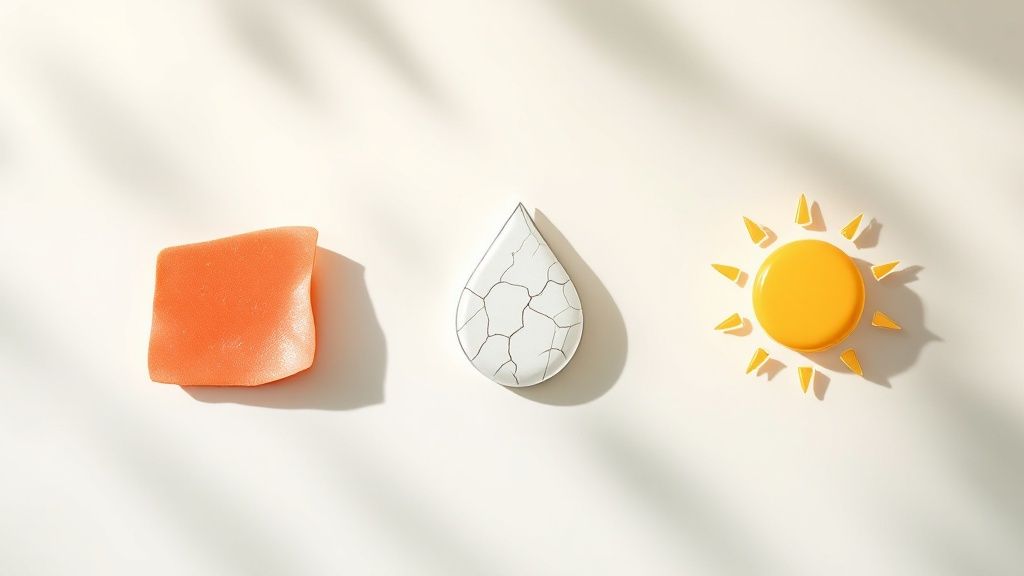
To make it simple, think about where you are in your skin journey. Each of these ingredients excels in different situations, and figuring out which one sounds like you will lead you to the most effective option. This clarity stops you from picking something too weak to make a difference or too strong for your skin to handle.
Your Guide to Choosing the Right Retinoid
Here’s a straightforward breakdown to help you decide. See which of these scenarios best describes you.
Opt for Retinol if you:
- Are new to Vitamin A and want to ease into it safely.
- Have sensitive or reactive skin that easily gets red or irritated.
- Are focused on long-term prevention and tackling the very first signs of aging, like tiny fine lines.
- Want to improve your overall skin texture and tone without needing a prescription.
For anyone just starting out, we love the BARB N.P. Retinol Serum. It’s formulated to deliver real anti-aging results while being gentle enough to minimize that initial irritation, making it the perfect first step.
Consult a doctor about Retin-A if you:
- Are fighting persistent, moderate-to-severe acne that just won't clear up with other treatments.
- Have significant sun damage, including deep-set wrinkles and noticeable dark spots.
- Are looking for faster, more dramatic results and are ready for the initial "retinization" phase of dryness and peeling.
- Have resilient skin and have already used high-strength over-the-counter retinols with no problems.
How to Integrate Retinoids Into Your Routine
Once you've made your choice, how you introduce it to your skin is critical for getting great results and minimizing side effects. Whether you go with retinol or Retin-A, some rules are simply non-negotiable.
The most common mistakes I see are using too much, too soon, and skipping sunscreen. A pea-sized amount is all you need for your entire face. And daily broad-spectrum SPF is an absolute must, since retinoids make your skin much more sensitive to the sun.
To help your skin adjust, try the "sandwich buffering" technique. You apply a layer of moisturizer, let it sink in, apply your retinoid, and then seal it with another layer of moisturizer. This can make a huge difference in reducing dryness. For help choosing the right hydrator, check out our guide on the best moisturizers for dry, mature skin.
Finally, hold off on using other potent actives like AHAs, BHAs, or vitamin C in the same routine as your retinoid—at least at first. You don't want to overwhelm your skin.
Supercharge Your Results With a Supportive Routine
Getting the most out of retinol or Retin-A isn’t just about the product itself. The real secret lies in building a supportive ecosystem for your skin. The right routine is what separates a smooth, glowing transition from a rocky, irritation-filled one.
Think of it this way: your success depends entirely on what you do before and after that single pea-sized application. A gentle, thoughtful approach is non-negotiable. This means ditching aggressive scrubs, harsh toners, and stripping cleansers. Those have no place here.
Building Your Retinoid-Friendly Regimen
Your routine is your support system. The goal is to buffer your skin against potential dryness and sensitivity while letting the vitamin A derivative work its magic.
- Gentle Cleansing: Start with a mild, pH-balanced cleanser. You want something that cleans away impurities without stripping your skin’s natural, protective oils.
- Deep Hydration: Follow up with a seriously hydrating moisturizer. I always tell my clients to look for ingredients like ceramides, hyaluronic acid, and glycerin to lock in moisture and fortify that all-important skin barrier.
- Daily Sun Protection: This is the most critical step, period. Retinoids make your skin more sensitive to the sun, leaving it vulnerable to damage. Daily, diligent use of a broad-spectrum sunscreen is the only way to protect your progress. Our guide on how to choose sunscreen can help you find the perfect one.
Elevate Your Routine With At-Home Technology
Beyond your daily topicals, certain at-home tools can give your skin an extra boost, helping manage side effects and amplify results. Light therapy, for instance, can be a total game-changer.
An at-home LED mask is an excellent partner for any retinoid routine. Its therapeutic light helps calm the inflammation and redness that often pop up during that initial adjustment phase, while also delivering its own collagen-stimulating benefits.
The BARB N.P. Facial Mask is an outstanding choice to complement your treatment. Its red light setting is specifically designed to reduce inflammation and enhance collagen production—exactly what your skin needs as it adapts.
Best of all, it has a convenient wireless design and a comfortable fit, so treatments feel effortless, not like a chore. With 3 versatile lighting settings, you can customize your sessions to tackle multiple concerns, ensuring your entire routine works in perfect harmony.
Your Retinol & Retin-A Questions, Answered
Navigating the world of retinoids always brings up a few key questions. Let's clear up some of the most common concerns so you can feel confident in your skincare choices.
Can I Use Retinol and Retin-A at the Same Time?
Absolutely not—and I can't stress this enough. Using both is not only redundant but also a recipe for angry, irritated skin.
Think of it this way: Retin-A is already the most potent, active form of Vitamin A your skin can use. Adding retinol on top is like trying to put gas in a car that's already full—it doesn’t help, it just makes a mess. You won't get better results, but you will dramatically increase your risk of severe dryness, peeling, and redness. Stick to one and let it do its job.
How Long Until I See Results?
This is where patience becomes your most important skincare ingredient. Great results take time and consistency.
- Over-the-counter retinol: You'll likely notice initial improvements in texture and tone around the 8-12 week mark. For more significant anti-aging benefits, like softened fine lines, give it at least six months of steady use.
- Prescription Retin-A: If you're treating acne, you could see clearing start in as little as 6-8 weeks. For texture, wrinkles, and sun damage, you’re looking at a three to six-month timeline for those truly noticeable changes.
The biggest mistake I see clients make is going too hard, too fast, and forgetting sunscreen. Start with a pea-sized amount just 2-3 times per week to let your skin adjust. And daily broad-spectrum sunscreen is non-negotiable. Retinoids make your skin more vulnerable to the sun, and skipping SPF will undo all your hard work.
To give your skin some extra support, consider adding an at-home LED therapy device to your routine. The Barb N.P. Facial Mask is a fantastic choice, using red light therapy to calm inflammation and boost collagen from a different angle. Its comfortable, wireless design makes it an effortless addition to your retinoid journey.
Ready to build a routine that delivers real results? Explore the curated collection of medical-grade skincare at BotoxBarb and find the perfect products to support your skin's transformation. Visit us at https://barbnp.shop to get started.

